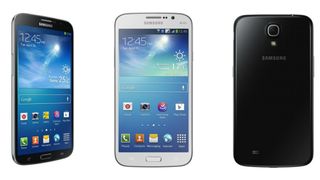Samsung reveals 6.3-inch and 5.8-inch Galaxy Mega
Hulk phone smash

Samsung has finally lifted the veil off its mythical, supersized Galaxy Mega, which will be arriving in both 6.3-inch and 5.8-inch versions.
Taking the crown from the Galaxy Note II for Samsung's biggest smartphone, the 6.3-inch Mega sports a HD screen for landscape support, while the handset itself is powered by a 1.7GHz dual-core processor with 1.5GB of RAM.
Meanwhile, the 8 megapixel rear camera and 1.9 megapixel frontfacing snappers bring the twin-camera love, though they don't quite match up those found on the Galaxy S4.
Phabulous
The 5.8-inch model, on the other hand, takes an expected step down in power, pushing the resolution down to qHD (960 x 540), while running on a 1.4GHz dual-core processor.
The Mega runs on Android 4.2, along with LTE and HSPA radios and GPS functionality. As for when you can get your extra-large hands on it, the phone is set to launch in the US and UK in May.
Check out Samsung's
Get daily insight, inspiration and deals in your inbox
Get the hottest deals available in your inbox plus news, reviews, opinion, analysis and more from the TechRadar team.
to discover loads more about the infinite possibilities of the GALAXY Note II
Update: It has been confirmed that the Samsung Galaxy Mega 5.8 will not be coming to the UK, so those of you who are in Britain will have to make do with the massive 6.3-inch version.
There's nothing on pricing yet, though one unofficial EU retailer has the larger Galaxy Mega 6.3 listed for €699 (around £600/$900/AUS$865).
We've had a scout around but so far there's no sign of retailers putting up pre-registration pages. We expect that will change very soon.
Hugh Langley is the ex-News Editor of TechRadar. He had written for many magazines and websites including Business Insider, The Telegraph, IGN, Gizmodo, Entrepreneur Magazine, WIRED (UK), TrustedReviews, Business Insider Australia, Business Insider India, Business Insider Singapore, Wareable, The Ambient and more.
Hugh is now a correspondent at Business Insider covering Google and Alphabet, and has the unfortunate distinction of accidentally linking the TechRadar homepage to a rival publication.

